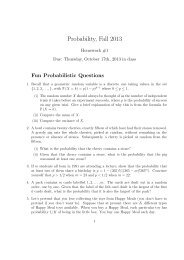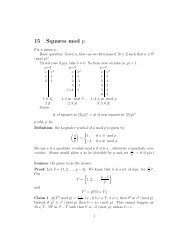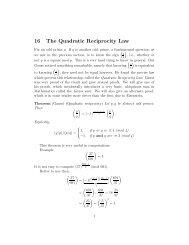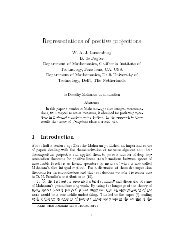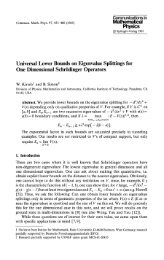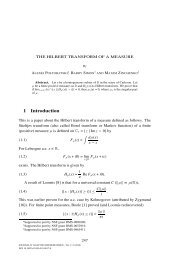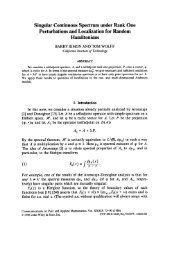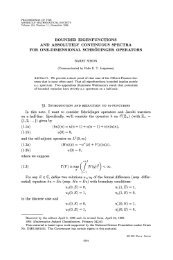Banach Lattices and the Dual of C(X)
Banach Lattices and the Dual of C(X)
Banach Lattices and the Dual of C(X)
Create successful ePaper yourself
Turn your PDF publications into a flip-book with our unique Google optimized e-Paper software.
4 NOTES FOR MA 110A<br />
we find that<br />
For λ > 0 <strong>and</strong> real,<br />
<strong>and</strong><br />
ℓ+(g + h) = ℓ+(g+ + h+) − ℓ+(g− + h−)<br />
= ℓ+(g+) + ℓ+(h+) − ℓ−(g−) − ℓ+(h−)<br />
= ℓ+(g) + ℓ+(h)<br />
ℓ+(λf) = ℓ+(λf+) − ℓ+(λf−) = λℓ+(f)<br />
ℓ+(−f) = ℓ+(f−) − ℓ+(f+)<br />
= −ℓ+(f)<br />
Therefore, ℓ+ is a linear functional.<br />
Clearly,<br />
so<br />
<strong>and</strong> ℓ = ℓ+ − ℓ−.<br />
Note that<br />
ℓ+(f) ≥ ℓ(f)<br />
ℓ− ≡ ℓ+ − ℓ ≥ 0<br />
ℓ−(f) = sup(ℓ(g − f) | 0 ≤ g ≤ f)<br />
= sup(−ℓ(h) | 0 ≤ h ≤ f) (2.4)<br />
by taking h = f − g.<br />
Suppose ℓ = k+−k−. Then 0 ≤ g ≤ f implies ℓ(g) = k+(g)−k−(g) ≤<br />
k+(g) ≤ k+(f), so taking sups, ℓ+ ≤ k+. Using (2.4), we get ℓ− ≤ k−.<br />
Finally, given f ≥ 0 <strong>and</strong> g, h so 0 ≤ g ≤ f, 0 ≤ h ≤ f, we have<br />
−f ≤ g − h ≤ f, so |g − h| ≤ f <strong>and</strong> so by <strong>the</strong> <strong>Banach</strong> lattice property<br />
g − h ≤ f. Thus,<br />
|ℓ(g) − ℓ(h)| = |ℓ(g − h)|<br />
≤ ℓ g − h<br />
≤ ℓ f<br />
Taking <strong>the</strong> sup <strong>of</strong> ℓ(g) over all g <strong>and</strong> −ℓ(h) over all h, we find that<br />
(2.2) holds. <br />
Corollary. If ℓ ∈ C(X) ∗ , <strong>the</strong>n ℓ = ℓ+ − ℓ− with ℓ± ≥ 0 <strong>and</strong><br />
ℓ+ + ℓ = ℓ (2.5)



